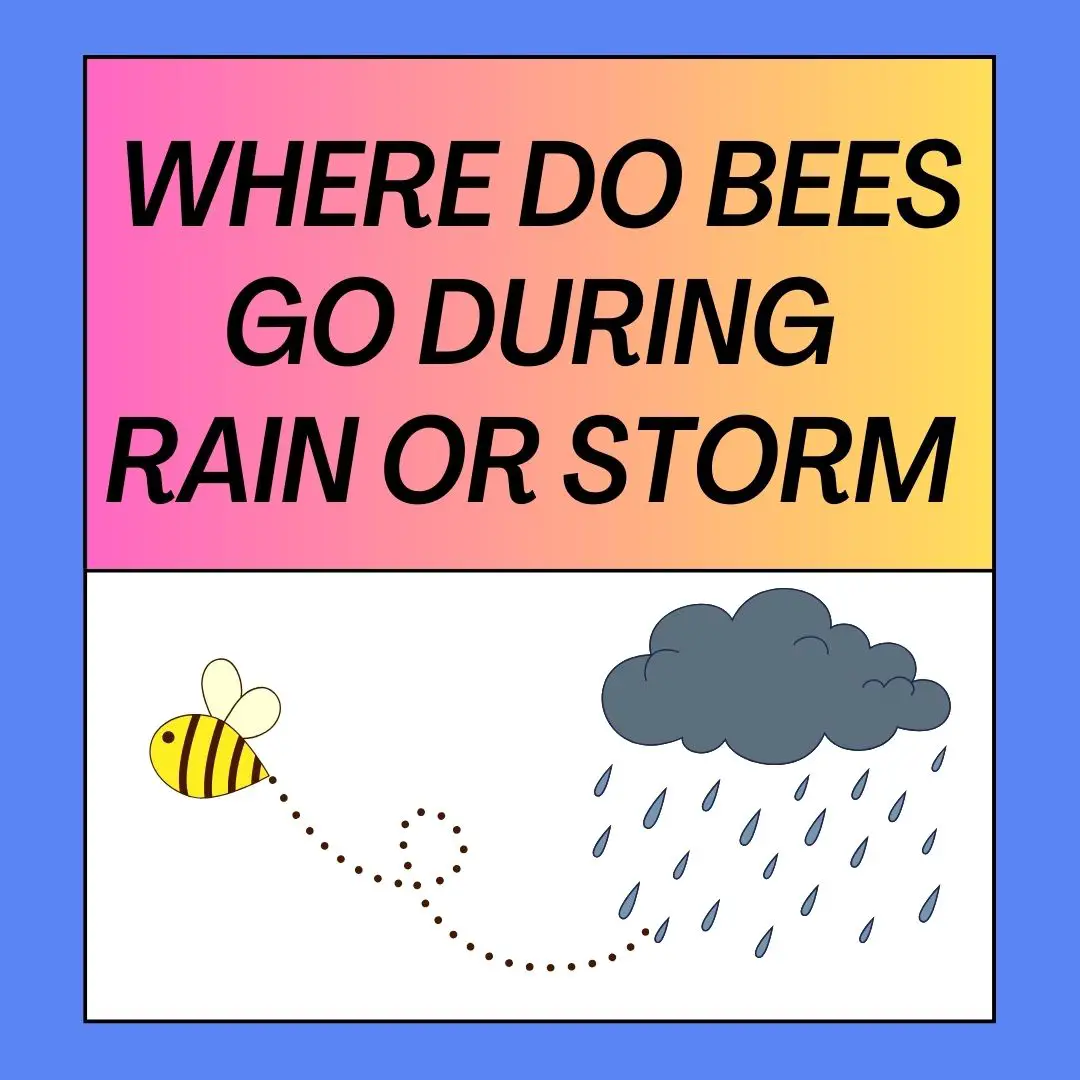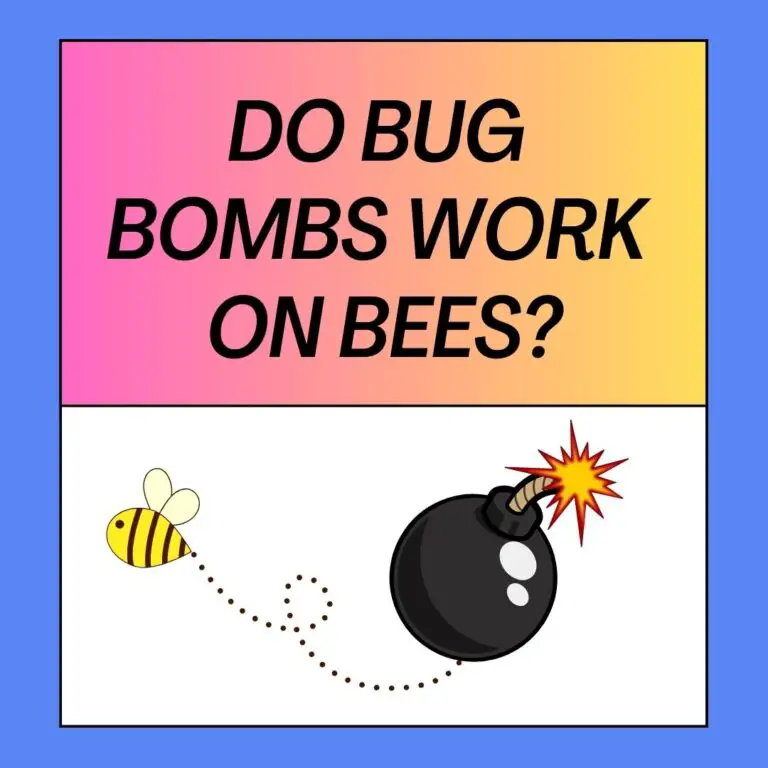
When it rains, bees seek shelter to protect themselves and their colonies. Rain can be problematic for bees because their bodies are not designed to handle excessive moisture.
4 Places where bees go when it rains:
- Back to the Hive: Most honeybee species will return to their hives when it starts to rain. Honeybees are particularly vulnerable to rain because they are relatively large, and their bodies can become waterlogged. Rain can also dilute the nectar they’ve collected, making it less suitable for honey production. Bees in the hive will huddle together and wait for the rain to stop.
- Sheltered Flowers: Some solitary bees, such as mason bees and carpenter bees, might seek refuge under flower petals or other vegetation. They will wait until the rain stops before resuming their foraging activities.
- Stay Put: Foraging bees that are already out when the rain begins may seek shelter under leaves, flowers, or any available dry spot. They will cling to these surfaces until the rain stops, and then continue their flight.
- Resilience: Bees are generally resilient insects and can tolerate a light rain shower without too much trouble. However, heavy or prolonged rain can be detrimental to their foraging and potentially lead to losses in nectar and pollen resources.
It’s important to note that while bees seek shelter from the rain, they have various strategies to deal with wet conditions. For instance, they can adjust their body temperature to evaporate moisture and dry themselves off when they return to the hive.
Providing shelter for bees in your garden, such as bee boxes or covered areas with nectar-rich flowers, can be beneficial during rainy weather. This helps support local bee populations and ensures that they have access to food and shelter, even when the weather is less favorable.
Bees and Weather Prediction
1. Barometric Pressure:
- Bees are capable of sensing changes in barometric pressure. A drop in pressure, which often precedes bad weather such as rain or storms, can alert bees to impending changes in their environment. When they detect a drop in pressure, they may exhibit certain behaviors like returning to the hive earlier than usual.
2. Temperature:
- Bees are ectothermic, meaning their body temperature is regulated by the surrounding environment. Weather changes, particularly drops in temperature, can influence their activity levels. On cooler, overcast days, bees may be less active, while they become more active during sunny and warm conditions.
3. Wind and Air Movement:
- Wind can impact a bee’s ability to fly and navigate. Strong winds can make flying difficult and disrupt their foraging patterns. Bees are sensitive to wind conditions, and they may avoid flying during gusty weather.
4. Rain and Precipitation:
- Rainfall can directly impact a bee’s ability to forage for nectar and pollen. Bees typically avoid flying in heavy rain, as raindrops can be heavy relative to their body size, making flying challenging. They may seek shelter in their hives during rainy weather.
5. Cloud Cover:
- Bees use the position of the sun in the sky for navigation. Cloudy or overcast skies can obscure the sun, making it more difficult for bees to navigate accurately. This can affect their foraging behavior and orientation.
6. Foraging Behavior:
- Bees are highly efficient foragers and have a keen sense of time. They adjust their foraging patterns based on environmental conditions. When they sense changes in weather, such as the approach of a storm or heavy rain, they may expedite their foraging activities to gather resources before the weather worsens.
7. Hive Behavior:
- Inside the hive, bees exhibit weather-related behaviors. They may change the ventilation within the hive to regulate temperature and humidity in response to external weather conditions. For example, they might vigorously fan their wings to cool the hive on hot days.
While bees do not predict weather like humans, their sensitivity to environmental cues helps them adapt and respond to changing weather conditions effectively. This adaptability is critical for their survival and their role as pollinators, ensuring the health of ecosystems and crops.
How to Help a Rain-Soaked Bee?
Encountering a rain-soaked bee can be a common sight during wet weather. Bees are highly vulnerable when wet because their wings become heavy and less functional. If you come across a rain-soaked bee and want to help it, here are some steps to follow:
1. Assess the Situation:
- Approach the bee gently and carefully. Make sure it is rain-soaked and not injured or exhausted from other causes.
2. Offer Shelter:
- Find a suitable place to provide temporary shelter for the bee. You can use a leaf or a piece of paper to create a small shelter, like an umbrella, to shield it from further rain. Make sure the shelter doesn’t crush the bee.
3. Allow Drying Time:
- Place the bee in the sheltered area and wait for it to dry naturally. Bees have tiny hairs on their bodies that help absorb moisture, and given some time, they can often dry themselves out and regain their ability to fly.
4. Provide a Sugar Solution:
- If the bee appears weak or exhausted, you can help by providing a simple sugar solution. Mix one part sugar with two parts water to create a sugar water solution. Place a small drop near the bee’s mouthparts (proboscis) to provide energy. This can help revive a tired bee.
5. Be Patient:
- Sometimes, it may take a while for a bee to recover and fly away. Be patient and give it the time it needs. Avoid touching or handling the bee excessively, as this can cause stress.
6. Offer Nectar-Rich Flowers:
- If you have access to nectar-rich flowers, place the bee near them once it has dried off and appears more active. This can provide a food source for the bee and help it regain strength.
7. Avoid Harmful Substances:
- Ensure that any substances you offer to the bee are safe. Do not use honey, as it can transmit diseases to wild bees. Stick to sugar water, which is a safe and easily accessible energy source.
8. Provide a Perch:
- If the bee has regained its strength but seems unable to fly, you can offer a safe place for it to rest. Place it on a flower or leaf so it can recover fully before taking to the skies again.
9. Educate Others:
- Share your knowledge about helping rain-soaked bees with friends and family. Encourage them to assist bees in need when they come across them.
Remember that bees play a vital role in pollinating plants, including many of our food crops. Helping a rain-soaked bee is a small but meaningful contribution to supporting these essential pollinators and ensuring the health of ecosystems.
How to Help Stranded Bees During Rains and Storms
Spring showers and storms can sometimes catch bees off guard, leaving them stranded and vulnerable. Here are some ways you can help bees during spring rain and storms:
1. Provide Shelter:
- If you have beehives, make sure they have suitable hive covers or roofs to protect them from heavy rain. Providing a shelter or awning above the hive entrance can also prevent rain from entering.
2. Create Rain Shelters:
- Place small structures or upside-down flower pots near your garden or in areas where you often see bees. These can serve as temporary shelters during sudden storms.
3. Offer Flowers with Cover:
- Plant flowers with large petals that can act as natural umbrellas for bees during rain. Examples include hollyhocks, sunflowers, and foxgloves.
4. Avoid Using Pesticides:
- During rainy weather, refrain from using pesticides or insecticides in your garden. Bees may seek refuge in your garden, and exposure to chemicals can harm them.
5. Set Up Bee Baths:
- Provide shallow containers of water with small stones or cork pieces as landing pads. Bees can land on these to drink without the risk of drowning.
6. Plant Windbreaks:
- Wind can make rainstorms more challenging for bees. Planting windbreaks like shrubs or tall plants can help reduce the impact of strong winds on bee populations.
7. Rescue Grounded Bees:
- If you find rain-soaked bees on the ground, gently pick them up with a leaf or piece of paper and place them under a flower or in a sheltered area. Allow them to dry off and recover.
8. Provide Sugar Water:
- In extreme cases, where bees are weak and struggling, you can offer a sugar water solution. Mix one part sugar with two parts water and place a small drop near the bee’s mouthparts. This can provide an energy boost.
9. Educate Others:
- Raise awareness among your friends and family about the importance of helping stranded bees during storms. Encourage others to take similar actions.
10. Create Bee-Friendly Habitats: – Design your garden or outdoor space to be bee-friendly year-round. Plant a variety of bee-attracting flowers, provide nesting sites, and minimize pesticide use.
Related FAQ’S
How Do Bees Navigate?
- Bees use a variety of methods to navigate, including the sun’s position, landmarks, and even the Earth’s magnetic field. Rain and clouds can disrupt their ability to navigate, which is another reason they tend to avoid flying in heavy rain.
4. Where Do Bees Take Refuge?
- When it starts raining, bees often seek refuge in their hives. Worker bees return to the hive, and they may temporarily close the entrance to keep rain and other intruders out.
5. How to Help Bees Stranded in Sudden Storms?
- Sudden storms can pose a threat to foraging bees. Bees caught far from the hive in unexpected downpours may struggle to find shelter and may become stranded.
6. How to Help a Rain-Soaked Bee?
- If you come across a rain-soaked bee, you can help by gently moving it to a dry spot. You might offer a small amount of sugar water to revive it. However, handle bees with care to avoid getting stung.
7. What Happens to Bees If They Get Wet?
- Bees that get wet can become lethargic because their wings become heavy and they may struggle to fly. This is why they seek shelter during rain.
8. Can a Bee Survive After Getting Wet?
- Bees can usually survive getting wet if they find shelter and have a chance to dry off. However, extended exposure to rain or cold can be detrimental.
9. Where Do Bees Shelter When It’s Raining Heavily?
- Bees shelter in their hives when it’s raining heavily. Worker bees will remain inside, and guards might temporarily block the hive entrance to keep rain out.






